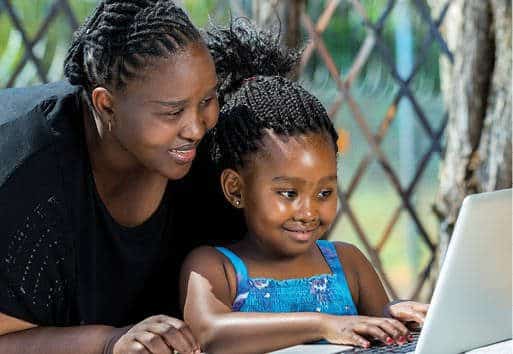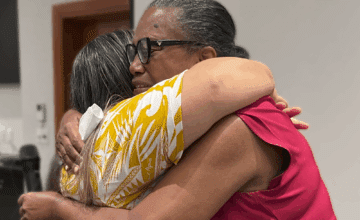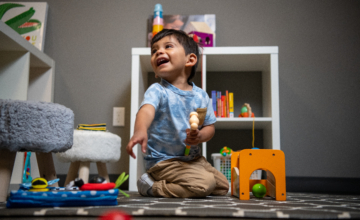Dawn M. Curtin and Linda L. Wilson, The Enola Group, Inc. Morganton, North Carolina

Abstract
Early Head Start’s intensive home- and center-based comprehensive services include proven significant impacts on young children’s development and on parent’s knowledge and behavior. However, how does a program continue delivery of supports and resources in a global health crisis? This article presents an overview of The Enola Group Early Head Start program’s creative response to the challenges and opportunities during the COVID-19 pandemic. The authors provide examples of practices used by administrators, in-home educators, center-based teachers, and others to support children, families, each other, and the communities in which they live.
The Enola Group Early Head Start (TEG EHS) program has successfully supported infants and toddlers and their families, and expectant women and their families for more than 18 years. The program serves Alexander, Burke, and Caldwell counties in western North Carolina. TEG EHS uses the evidence-based Early Head Start home-based model and center-based model (Head Start ECLKC, 2018) to serve 200 enrolled children and families. TEG EHS uses the Creative Curriculum Teaching Strategies GOLD (Teaching Strategies, 2011) to ensure and assess that children are meeting early learning goals and objectives. The program also uses a capacity-building parenting curriculum that focuses on parenting competence, confidence, and enjoyment.
This past year, the COVID-19 pandemic presented our program with new challenges and opportunities. Staff members absorbed a plethora of information, responded to ever-changing guidelines, and developed new strategies to deliver needed services and resources to children, families, and the communities we serve. The challenges we faced included closing our early childhood education centers for 2 months; suspending in-person home visits, socializations, group parenting education, and community field trips; and discontinuing in-person community recruitment activities and networking events.
The frequency and quality of interactions with children and families are essential components of any Early Head Start program. These interactions have an impact on outcomes for child and family. We had to shift our actions as teachers, in-home educators, and program leaders. We responded quickly to families who faced losing child care, had food shortages, lost jobs, or reduced work hours, and were disconnected from social supports and resources. We also discovered that many TEG EHS employees and their families were experiencing similar stressful situations during this time. This article describes some of the needs in our program and the ways we addressed the needs created by the pandemic.
Center-Based Action Planning
The need. We needed to feel intentional, purposeful, and connected to the people we were serving. We needed to feel that we were making a difference. How could we do that in a time of social distancing? Teachers and other staff members knew they needed a plan to keep families engaged in learning, support their parenting, and keep them connected to each other. Teachers were tasked with creating a new way to provide learning opportunities for the children and families outside of their classrooms.
What we did. Teachers and other staff members immediately rose to the challenge by setting up new routines that included making daily calls to children and families, planning virtual activity lessons, developing individual and group parent engagement strategies, and having conversations to maintain and cultivate relationships with children and families. Teachers also tapped into their creativity and ingenuity to keep families connected and provide activities that promoted interest-based learning opportunities in the home setting. Teachers’ contacts were considered a critical support by families. One parent said, “The continued connection with my child’s teacher was a lifeline for me and my family. They kept us afloat in the storm.” Another family stated that the contact with her child’s teacher helped her and her daughter to feel like “they weren’t forgotten.”
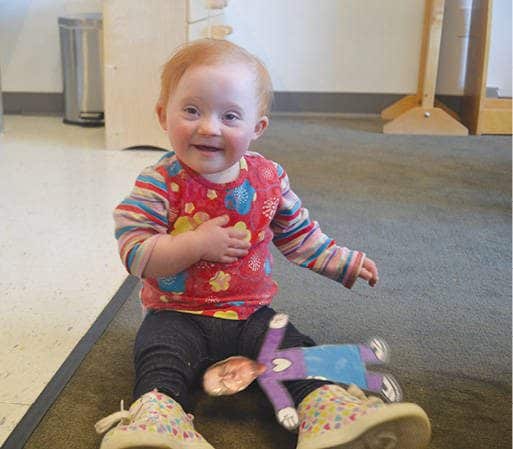
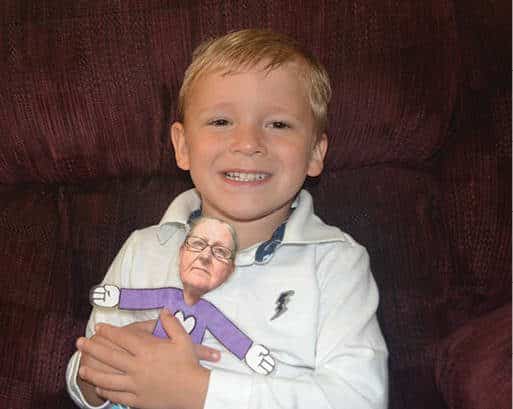
The children received a Flat Vickie in the mail and parents took pictures of their children with their “teacher, Flat Vickie,” doing activities in their homes. Photos: Courtesy of the families
One popular activity was a weekly story about the classroom pet guinea pig, Cocoa Bean. The teachers wrote stories that helped keep children connected to a “normal” part of their pre-COVID daily routines. The illustrated Adventures of Cocoa Bean were emailed, mailed, or delivered to families each week so that they could enjoy them as often and as much as they wanted. Stories about Cocoa Bean’s experiences included going on a field trip to one teacher’s farm to meet new animal friends; daily routines, like washing hands and eating lunch; situations and emotions related to social distancing; and an exciting day outside in the garden. Families loved the weekly story about Cocoa Bean, and many said the stories were a bright moment in a not-so-bright time.
Another teacher created “Flat Vickie,” based on the story of “Flat Stanley.” The teacher drew an outline of a body and glued a picture of her face to it. The teacher read the story of Flat Stanley to the children and families during a videochat and then introduced the children to Flat Vickie. The teacher then challenged the families to take Flat Vickie to three different places or include her in doing three different activities in their home (e.g., eating breakfast, going outside, and cleaning up toys). Then the children were to tell their teacher about what they did with Flat Vickie the next time they spoke with each other. Each child received a Flat Vickie in the mail with a description of the activity challenge. The result included parents taking pictures of their children with their “teacher, Flat Vickie” doing activities in their homes. Pictures were shared on social media or mailed back to the teacher. We are still hearing reports of Flat Vickie and her escapades. One child takes Vickie everywhere and, according to her mom, even needed a car seat for Flat Vickie. Teachers also dropped off materials to homes (porch/ door drop offs) for children and families to create art, do scrapbooking, and keep reading journals. Teachers read stories in videochats, recorded phone messages, held story time over the phone, organized live virtual dance parties, shared resources, monitored parent logs of activities related to goals, and created and shared many other literacy activities.
Teachers also shared ideas for extending their children’s learning through play while being at home. Stay-at-home orders allowed parents to establish and maintain home routines with teacher support and helped parents recognize that these small strategies could help their child feel safe and secure.
Home-Based Action Planning
The need. Building capacity and focusing on parenting competence, confidence, and enjoyment are all essential components of the TEG EHS home-based program services. How were we going to provide home-based service without being in the homes of the children and families enrolled in our program? How will these families get specific information that targets their needs? What additional support will they need? These questions helped guide us in planning how to best support families in our home-based program.
What we did. In-home educators and other staff members gathered information from families, program data, and community organizations to provide individualized supports to children and families. All staff members worked together to share information and updates to community resources for food, transportation, diapers, and medical services available to families and distributed any new information daily. In-home educators made phone calls to families to check on their well-being, discuss immediate needs, and ask how the stay-at-home order was affecting their household.
Then we focused on figuring out how to implement child learning. To do so, we discussed strategies and asked the family about their ability to access the Internet. We reviewed our community assessment, researched what public schools were doing, and considered county areas where no broadband was available. We spoke with families about the best ways to communicate with them. We were able to develop strategies using technology, including cell phones, computers, the Internet, and social media platforms to start building the foundation of our virtual home-based program support. In-home educators helped families learn how to navigate technology and virtual options. Staff members and individual families were able to establish regular contact virtually and become comfortable with having a “home visit” over a virtual platform. The program was able to purchase and provide families in need with hotspots to connect to the Internet. We used three-way interfaces and calls to utilize interpreters. Staff members were provided with an Internet stipend to help with that cost while working at home.
Once a virtual connection was established, staff members focused on child learning and on parenting support and engagement. Parents shared how the pandemic was affecting their family, and staff responded by helping to determine any immediate needs and developing plans to address those needs. In-home educators and parents identified goals for the children, based on their individual interests and abilities, and created or updated plans to reach those goals The in-home educators compared their experiences in delivering virtual home-based services as comparable to being coaches. Their role included helping parents identify child interests, abilities, and working with the family to develop learning experiences that would provide opportunities for the child to use these abilities.
Staff members asked questions, provided feedback, and identified which learning activities and strategies worked well and ones that did not. They helped parents gain confidence, learn new skills, and find joy in the interactions they had with their children while helping their children play and learn. In-home educators commented that they were not only coaches but became virtual cheerleaders to parents and family members. Staff members encouraged and shared with parents the specific ways they saw parents demonstrate their capabilities in meeting the challenges created by the pandemic by engaging in activities that supported their child’s learning. To some families, the TEG EHS staff were their only link to people outside their home. Staff members had regular contact with all families and more frequent contact with some. The connection to these families was critical to their well-being.
In-home educators made continuous efforts to maintain family engagement through Facebook Live playgroups, virtual story time, virtual parent discussion groups, outside socially distant play, and virtual cooking classes. They shared and connected with children by sending them cards and pictures, and creating virtual scavenger hunts.
In addition, staff members coordinated reverse “graduation” parades, where families drove by the center, received a certificate, and the staff wished them well. Staff members also drove by children’s homes honking and waving. One group of staff members planned a “drive-in story time” literacy event. Families and community members were invited to come to our office’s parking lot and park where they were able to see a screen that projected a staff member reading a story through a sound system. Families received a copy of the book, a related activity, and snacks so they could follow along with the reading and do an activity together in their car.
Actively Connecting Community
The need. During the initial response to the pandemic, children were no longer attending early childhood education centers or schools. Some parents and family members had lost their job, experienced reduced work hours, were waiting for or not eligible for unemployment, and were looking for resources and services to meet their families’ needs. The availability of enough food for children and their families was identified early on as a priority. Did the families we serve have enough food? Were they able to access it? Did they have finances to afford to buy food? The TEG EHS staff took action to help immediately by providing food to families, helping families feel comfortable asking for help, and helping to mobilize community food resources to support families.
What we did. When the TEG EHS determined a closing date for our early childhood education centers, we knew families who depended on their children receiving meals at the center were going to experience a strain on their household expenses. Early on, when the information came out that the stay-at-home orders were going into effect, teachers and managers inventoried the food at our centers and were able to distribute it to families in need. We also connected families with community food pantries and food hubs through the public schools. We previously had done this on an individual family basis, but because of the pandemic we switched to sharing these resources more often and in a broader way through phone calls, individual and group texts, emails, and social media postings. Also, program leadership staff encouraged and supported staff members who wanted to volunteer at community food banks on food distribution days. Their presence provided a familiar face to families that we served who may or may not have used the pantries before and supported a much-needed resource for the community services. Staff members not only volunteered but used these events to recruit families and share about our program’s EHS services.
Traditionally, one group of staff members organized an annual Thankful Luncheon in November. This is usually an in-person event where families and staff come together to eat and socialize. In 2020, staff members were determined to continue the tradition but knew there were restrictions because of COVID-19. The staff turned the Thankful Luncheon into a drive-through luncheon where 156 food plates were given out by staff members to families while they drove through the program’s parking lot.

Teachers also tapped into their creativity and ingenuity to keep families connected and provide activities that promoted interest-based learning opportunities in the home setting. Photo: Yaoinlove/shutterstock
On two occasions, the program gave families food to supplement their household food supply. We did this in two different ways. The first time, we purchased food from a variety of stores and put it in grocery bags which were picked up by families or delivered to their homes. The next time we purchased gift cards to local grocery stores that were designated for food purchases.
As the pandemic continued, the Office of Head Start encouraged programs to take advantage of available program flexibilities to ensure that children’s nutritional needs were being met. The staff were also able to explore and partner with churches, community outreach centers, and businesses to meet the needs of families. In addition to food, TEG EHS was able to help families in need with diapers, baby wipes, and formula when they were not readily available through other sources.
TEG EHS actively sought community partnerships to help address child and family nutritional needs. We were able to provide Cooking Matters®, a program that teaches parents and family members to shop for and prepare healthy meals on a budget. Initially, TEG EHS partnered with the public schools and a local church in Burke county. The cooking classes were conducted in person, outside in a church parking lot using the public school’s food truck, tables spaced out for social distancing, and a big screen monitor so the chef could be seen by all who participated. The chef presented the class instruction and demonstration while families used the same ingredients to cook along and prepare their own recipe. Each family also received all the ingredients to prepare the same meal again at home for their families.
TEG EHS staff members continued to provide Cooking Matters virtually with the help of Second Harvest Food Bank, Winston- Salem, NC, through a grant. The grant allowed for families to participate in virtual classes to receive information about nutrition and how to buy nutritious food on a budget. The classes provide experiences through interactive, hands-on lessons and digital education tools and resources.
Employee Emotional Support and Well-Being
The need. The program is extremely proud of the staff and the ways they rose to the occasion over and over as the pandemic generated new information, questions, priorities, and needs. It was important to make sure the program leadership, managers, and co-workers were sensitive to the needs of employees doing this important work. Staff members were supported in their work with families and with the needs of their own families as they experienced the stresses of the pandemic in their personal lives. The program leadership had to be clear about goals, vision, and expectations for the staff during the pandemic.
What we did. Program leadership and management staff had regular contact, reflected on how to support children and families, maintained our focus to achieve program goals, and supported employees during this crisis. We discussed the need for new policies that supported employees, including policies around a health crisis, safety protocols and guidelines, decisions on closing program locations, and supplemental pay for employees. Leadership staff had daily contact with each other. Managers had contact with staff members through phone calls, emails, texts, and reading the child and family contact notes staff members were writing and submitting into our database. Virtual team meetings and all-staff meetings were held in videoconferences. Leadership staff kept informed on the guidance from the Office of Head Start, the Centers for Disease Control and Prevention, state child care regulators, and local health departments.
TEG EHS historically relies on teamwork to approach our work with children and families, and during the pandemic, most staff members were working from home. They organized socially distanced staff picnics, and outdoor socially distanced lunches. Leadership used videoconferences to hold team meetings and trainings, which included some fun team-building experiences. Managers created opportunities for staff members to access and talk to a mental health consultant. When staff members started to come back to the office, management staff established schedules so they could alternate office days to reduce the number of staff members in the building. Rooms were rearranged if needed, and all locations followed guidelines from the Centers for Disease Control and Prevention.
Also, to help the staff stay engaged and motivated, and keep their creativity flowing, we created a “great idea” challenge.Each week during the stay-at-home order, staff members were encouraged to submit their “great idea” in working with the families enrolled.

Teachers also shared ideas for extending their children’s learning through play while being at home. Photo: Monkey Business Images/shutterstock
At the end of each week, a committee reviewed all the submissions and selected the best “great idea” for that week. The weekly winner received a gift card. In addition, we continued sharing “did you knows” through emails. These were notices about the good things that were happening for individuals, groups, and the program. For example, if a staff member completed coursework, or a grant was awarded, or a new staff member was hired, a “did you know” announcement was sent to everyone through email.
We discovered and tapped into creative and innovative ways to help the children and families we serve during the COVID-19 pandemic. The leadership and teamwork at all levels of the program helped make it all work. We continued to work, serve families, and support each other and continuously tried to stay one step ahead of the challenges and opportunities created by the pandemic. We also recognized and capitalized on the Office of Head Start’s quick response and leadership in providing guidance and flexibility to serve children and families in need during this global health crisis.
Authors
Dawn M. Curtin, MEd, is the director of the Child and Family and Early Head Start services for The Enola Group, a nonprofit organization committed to empowering children, families, and individuals in the foothills of western North Carolina. Ms. Curtin has more than 30 years of experience in early childhood field and recently attained a master’s degree in education from the University of North Carolina, Wilmington. Having worked in many different positions including infant–toddler and kindergarten teacher, center director, program coordinator, and program director, she brings her passion for quality early childhood education to the forefront of her dedication to children, staff, and families.
Linda L. Wilson has been the executive director of The Enola Group in Morganton North Carolina, for the past 2 years and has worked with young children and their families for more than 30 years. Ms. Wilson has a wide range of experiences including direct teaching in classrooms and in homes, program development and evaluation, training and staff development, and program management. She has coauthored publications about parent support and capacity-building practices, written and implemented numerous grants and projects, and has a wealth of knowledge and skills about child development, parent supports, and family capacity-building practices.
Suggested Citation
Curtin, D. M., & Wilson, L. L. (2021). An outbreak of creativity: Taking action to stay connected with children, families, and community during COVID-19. ZERO TO THREE Journal, 41(4), 36–40.
References
Head Start ECLKC. (2018). Home-based option. link
National Center on Early Childhood Development. (2015). Head Start early learning outcome framework. link
Teaching Strategies. (2011). The Creative Curriculum for infants, toddlers, and twos. link

